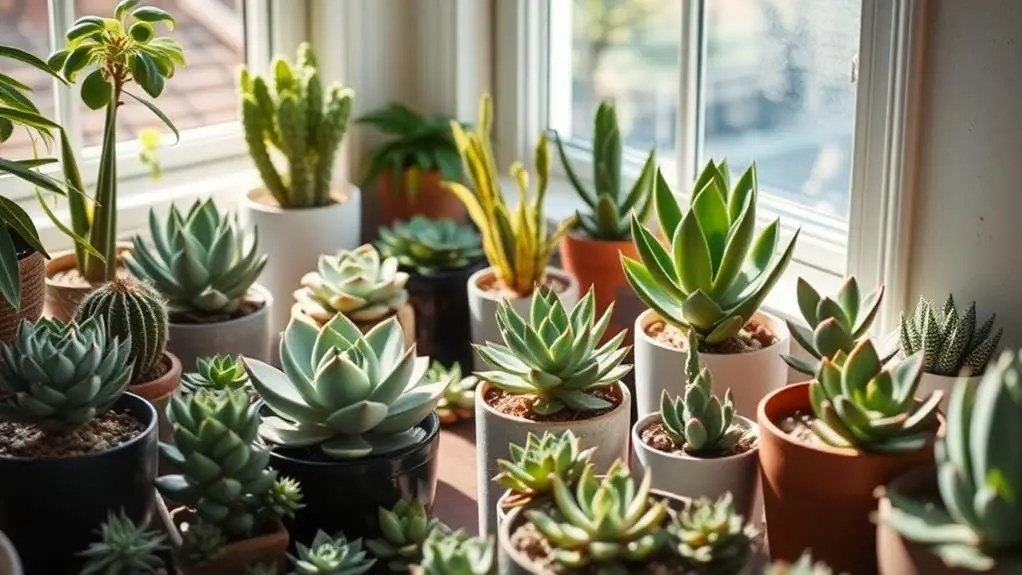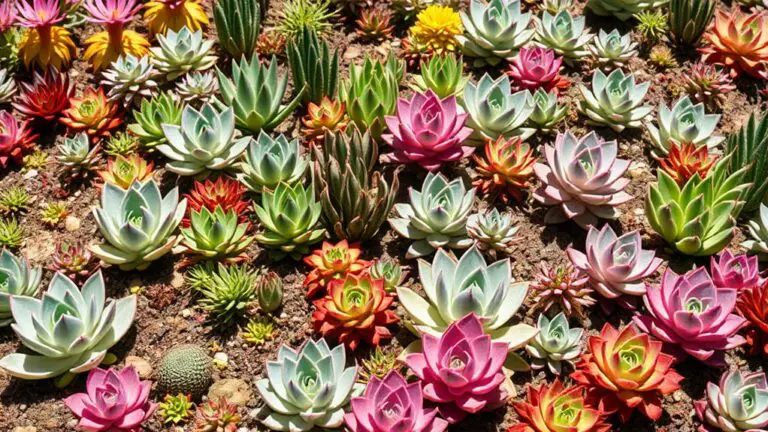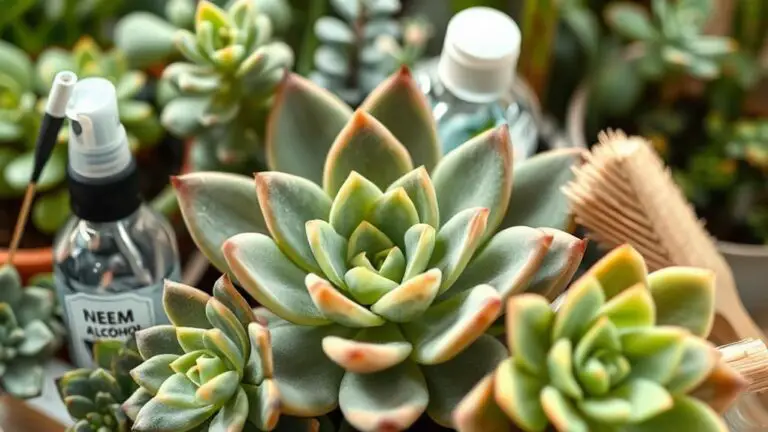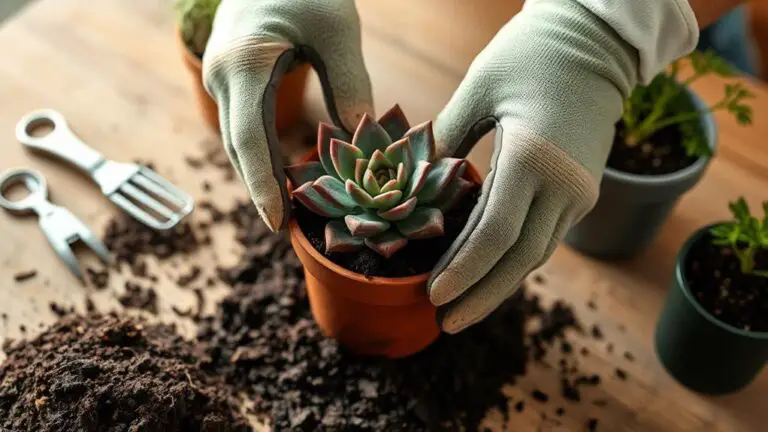7 Must-Know Succulent Care Tips for Beginners
Starting your journey with succulents can be both rewarding and a bit tricky if you don't know where to begin. You've probably heard that these resilient plants are easy to care for, but there are some vital aspects you shouldn't overlook. From selecting the right varieties to mastering the "soak and dry" watering method, each step plays a significant role in keeping your succulents thriving. But what about ensuring proper light exposure or dealing with those pesky pests? Stick around, and you'll uncover the essential tips that every beginner must know to achieve a lush, healthy succulent collection.
Selecting the Best Succulents
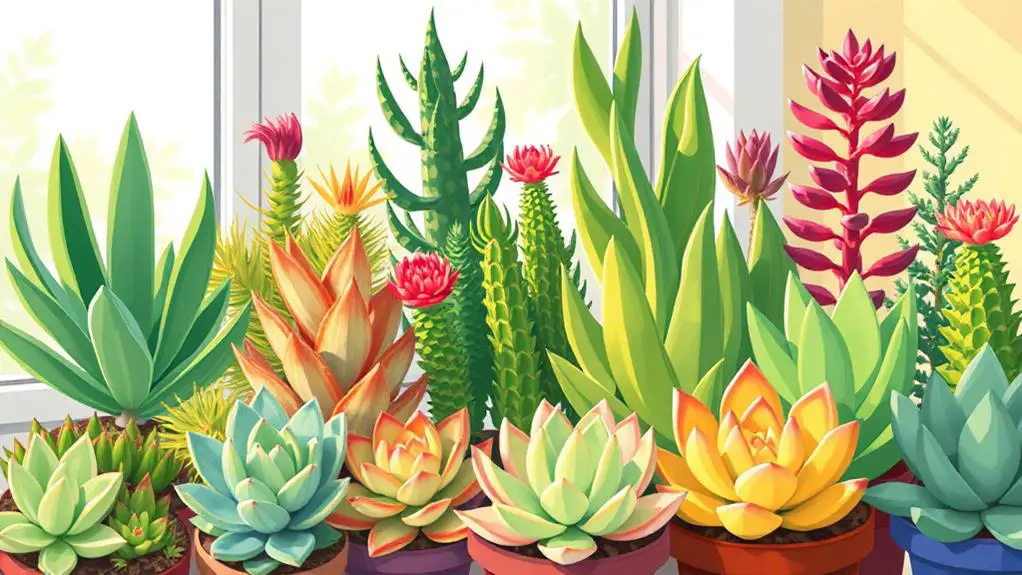
Choosing the right succulents is essential for beginners to guarantee a successful and enjoyable experience. Start by selecting easy-to-care-for varieties like Haworthia, Senecio String of Pearls, and Donkey Tail. These types are known for their resilience and low maintenance needs, making them perfect for those new to succulent care.
Light is a vital factor when selecting succulents. Most thrive in full sun and need at least 4-6 hours of sunlight daily. This makes them ideal for bright indoor spots or sunny outdoor areas.
If you're planning to grow succulents outdoors, consider resilient options like Sempervivum and Cactus. Sempervivum, for example, can withstand extreme temperatures, even as low as -30°F.
When selecting succulents, always match the variety to your environment. Some can tolerate shade, while others need direct sunlight to avoid stretching and maintain their compact form.
Assess your climate and conditions before purchasing. For indoor settings, choose succulents that adapt to lower light levels. If your home doesn't get enough natural light, consider using supplemental grow lights.
Proper Watering Techniques
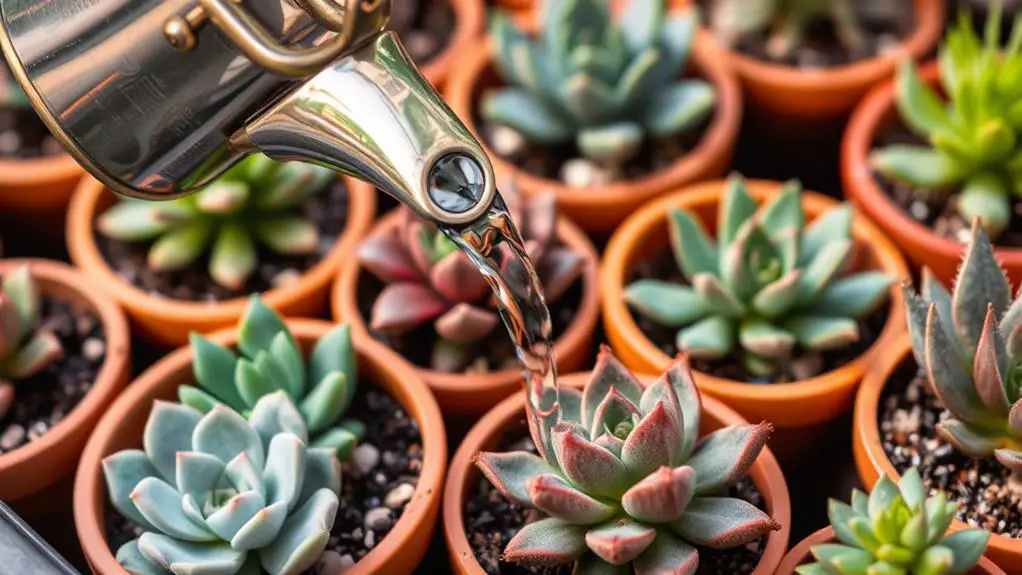
Watering succulents correctly is vital for their health and longevity. Start by checking if the soil is completely dry. Typically, you need to water your succulents every 10-14 days, but always verify the soil is dry before the next watering. You can use a moisture meter or simply stick your finger about 1.25 inches into the soil. If it feels dry, it's time to water.
Use the "soak and dry" method for the best results. This means you should soak the soil thoroughly until water drains from the bottom. Proper drainage is important to prevent root rot. After soaking, let the soil dry completely before you water the succulents again.
Avoid watering the leaves, as trapped moisture can lead to leaf rot. Instead, water directly onto the soil.
Adjust your watering schedule based on the seasons. During winter, succulents enter a dormancy period and need much less water.
Choosing the Right Pot
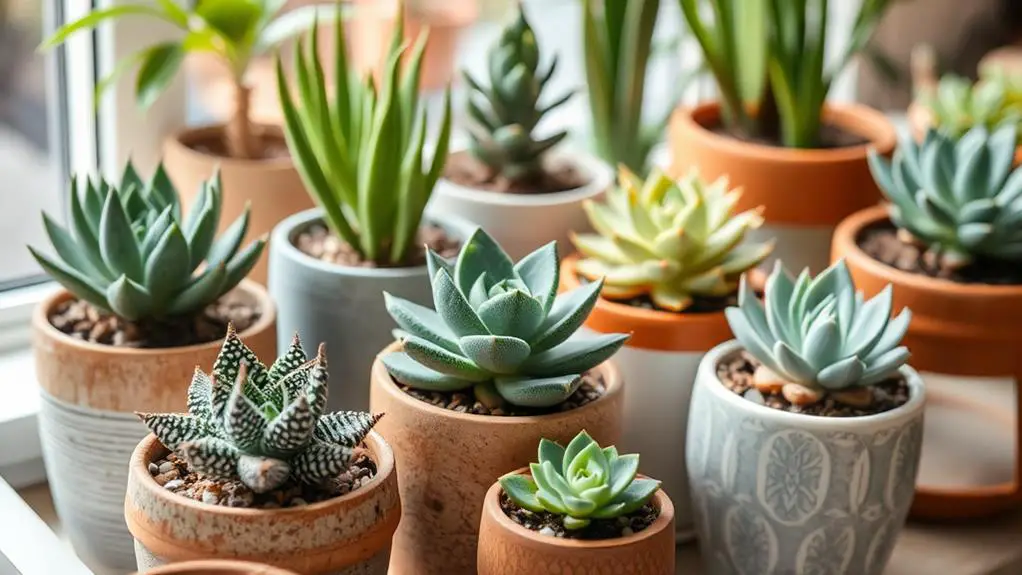
When it comes to selecting a pot for your succulents, ensuring proper drainage is essential to their health. Succulents don't like sitting in water, and too much moisture can lead to root rot. That's why it's vital to choose pots with drainage holes. These holes allow excess water to escape, keeping your plants' roots dry and healthy.
Terra-cotta pots are a great choice for succulents. Their porous nature allows for better airflow and helps water evaporate more quickly, making it easier to maintain well-drained soil.
Avoid non-draining pots like terrariums, as they can trap moisture and cause root health issues.
When picking a pot, make sure it's the right size. Smaller pots dry out faster and may need more frequent watering adjustments. Still, they're good if you're just starting and want to keep things manageable.
If you happen to have a pot without drainage holes, you can add pebbles at the bottom to enhance drainage and prevent waterlogging. This isn't ideal, but it can help in a pinch.
Ideal Soil Mix
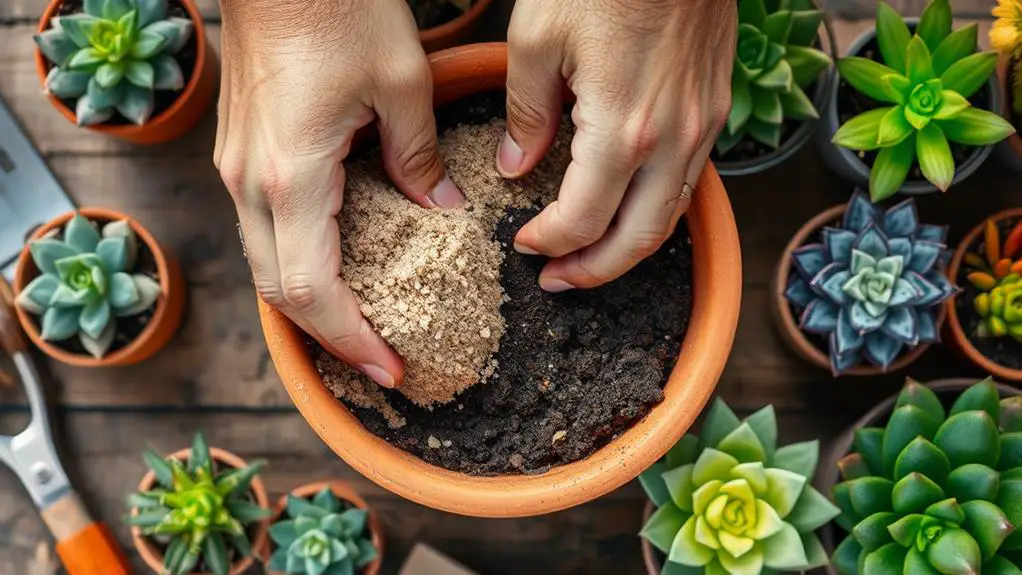
To guarantee your succulents thrive, it's crucial to use a well-draining soil mix specifically formulated for these plants. Regular potting soil retains too much moisture, which can lead to root rot. Instead, you need an ideal soil mix that promotes drainage and aeration. A good combination includes potting soil, sand, and either perlite or pumice. This mix helps water flow through easily, preventing your succulents from sitting in soggy soil.
Before watering, always make certain the soil is dry. Check the top 1.25 inches for dryness; this simple step will help you avoid overwatering, a common issue with succulents.
If your pot doesn't have drainage holes, consider adding gravel or pebbles at the bottom. These materials improve drainage and prevent excess moisture from harming your plants.
Remember to refresh the soil every 1-2 years. Over time, soil can lose nutrients that are vital for your succulents' growth. By replenishing the soil, you guarantee your plants continue to thrive in ideal conditions.
Following these tips will help you create the perfect environment for your succulents, making your gardening experience both enjoyable and successful.
Light and Temperature Needs
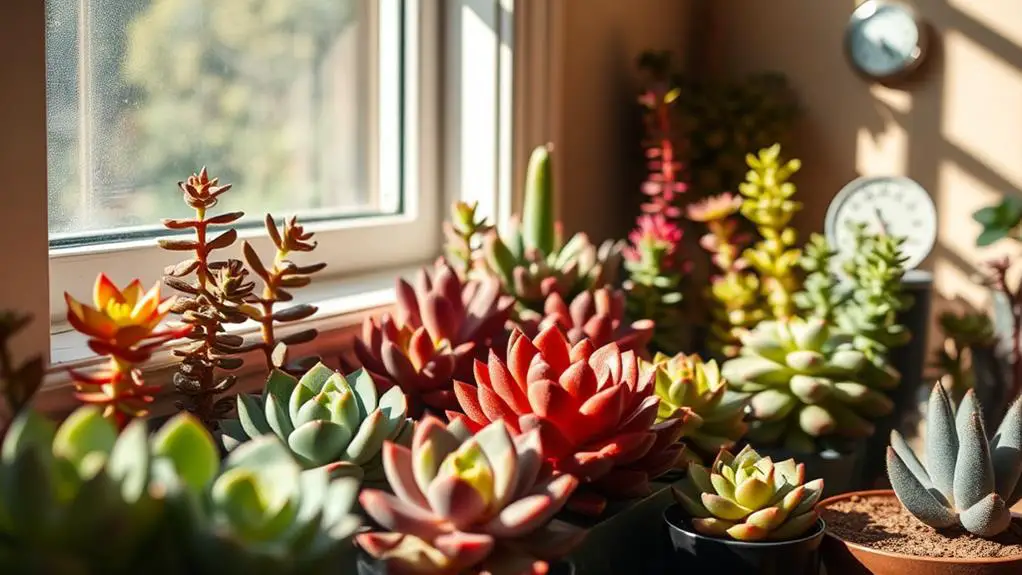
Creating the perfect soil mix is just one part of ensuring your succulents flourish. Another key aspect is meeting their light and temperature needs.
Succulents love sunlight, but too much direct sunlight can harm them. Aim for at least 4-6 hours of direct sunlight daily, though many varieties do best with bright, indirect light. If you notice your succulent's leaves stretching or leaning towards light, it's a sign it needs more light. Consider moving it to a sunnier spot or using supplemental grow lights.
Watch out for signs of too much sun, like burnt or discolored leaves. If this happens, move your plant to an area with filtered or indirect light.
Temperature is also essential. Succulents thrive in temperatures between 60°F and 80°F. Temperatures below 40°F can stress or damage your plants.
Grouping your succulents together can create a microclimate, enhancing humidity and light distribution. This helps them grow healthier and stronger.
Regular Plant Maintenance
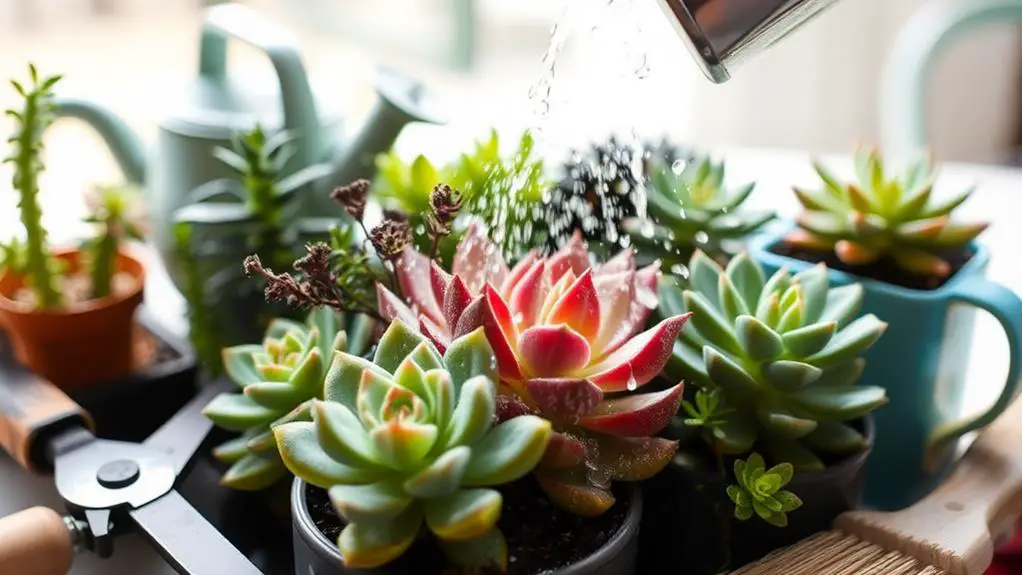
Consistency is key when it comes to regular plant maintenance for your succulents. Keeping your plants clean and tidy is vital for their health and appearance.
Start by regularly inspecting your succulents for any dead or decaying leaves. Removing these promptly helps prevent pest infestations and encourages healthy growth.
To make certain your succulents thrive, follow these steps:
- Inspect and Remove: Look for dead or decaying leaves. Gently remove them to keep your plant healthy.
- Dust the Leaves: Occasionally use a damp cloth to dust the leaves. This keeps them clean and helps them photosynthesize better.
- Rotate Weekly: Turn your succulents every week. This guarantees they get even light exposure and don't lean towards the light source.
- Trim Damaged Leaves: Cut off any damaged or wilted leaves. This encourages new growth and keeps your plant looking good.
Additionally, keep the area around your succulents clean and tidy. Removing debris can deter insects and create a healthier environment for your plants.
Regular maintenance may seem simple, but it's essential for keeping your succulents happy and thriving. By following these steps, you'll make certain your plants remain vibrant and beautiful.
Effective Pest Control
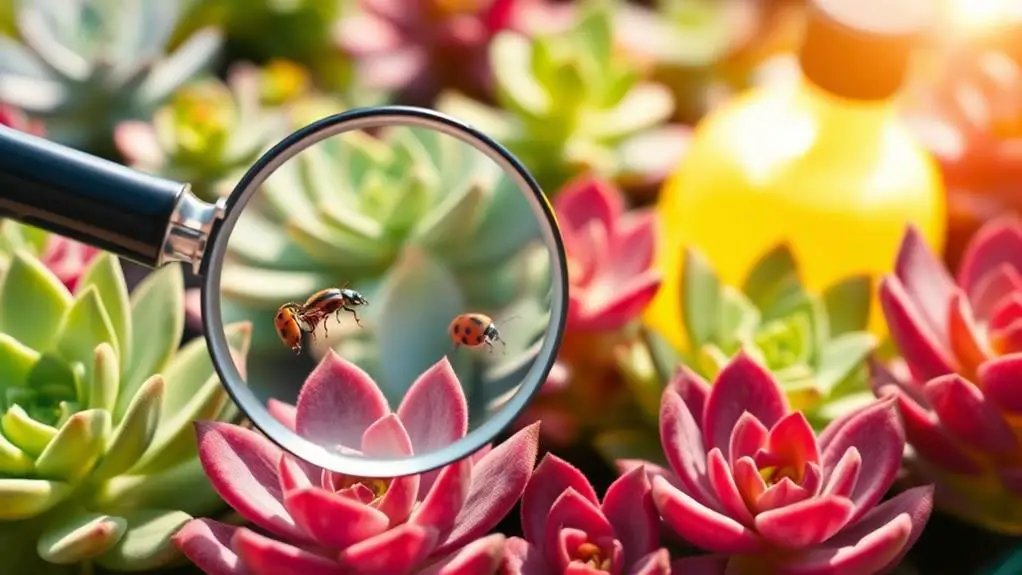
When caring for succulents, effective pest control is vital to their health and vigor. First, regularly inspect your succulents for pests like mealybugs, aphids, and spider mites. These tiny invaders can cause significant damage if left untreated.
Use insecticidal soap or neem oil to manage pest infestations effectively. Always follow the product instructions carefully to guarantee safe application and the best results.
To prevent pests from appearing in the first place, maintain a clean environment around your succulents. Dirt and debris can attract unwanted pests, so keep the area tidy and free of clutter.
If you notice any signs of a pest outbreak, isolate the affected plants right away. This will help prevent the infestation from spreading to the healthy plants in your collection.
For those growing succulents outdoors, consider encouraging natural predators like ladybugs. These helpful insects can keep pest populations under control organically, reducing the need for chemical treatments.
Frequently Asked Questions
How to Take Care of a Succulent for Beginners?
Water your succulent when the top 1.25 inches of soil is dry. Make certain pots have drainage holes and use well-draining soil. Provide 4-6 hours of bright, indirect sunlight daily, and check for pests regularly.
What to Do When You First Get a Succulent?
When you first get a succulent, choose a pot with drainage holes, ideally terracotta. Inspect for pests or damage, use well-draining soil, and place it in indirect sunlight. Water only when the soil is completely dry.
What Is the Secret to Growing Succulents?
The secret to growing succulents is providing well-draining soil, ensuring they get 4-6 hours of sunlight daily, and watering only when the soil is dry. Always use pots with drainage holes to prevent root rot.
Should You Mist Succulents?
You shouldn't mist succulents. Misting can lead to leaf rot and pest issues. Instead, water them directly at the soil level and guarantee the soil is completely dry before watering again to keep them healthy.
Conclusion
With these tips, you're ready to start your succulent gardening journey. Remember to choose easy-to-care-for varieties, give them enough sunlight, and water them correctly. The right pot and soil mix are essential, and don't forget to check for pests and keep your plants clean. Rotate them weekly for even growth. You've got this! Succulents can be a fun and rewarding hobby, so enjoy watching your plants thrive. Happy gardening!

